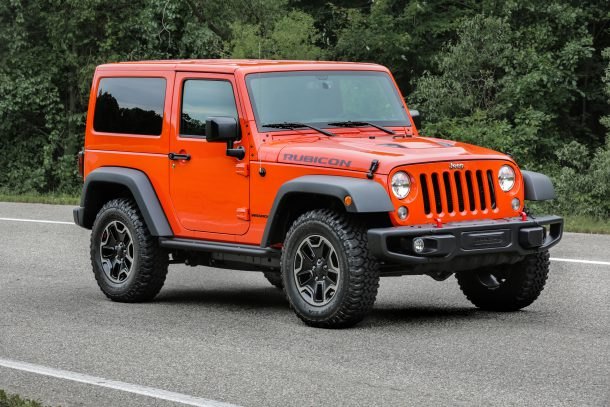Irrelevant 'Most-American Car' Ranking Changes Criteria, If Only to Flesh Out Results

While there are some who still proudly use the old slogan “ Buy American,” the concept is only loosely applicable to automobiles. While you can certainly support American brands, every automobile on the road is an amalgamation of parts from all over the world — and has been for quite some time.
This year, the automotive research website Cars.com, which began ranking the country’s “most-American” vehicles in 2006, was forced to change its criteria after only three models qualified under the old system of measurement.
For 2017, Cars.com has added country of engine origin, country of transmission origin, and U.S. factory employment relative to a company’s sales to its previous criteria of American parts content and final assembly location. It was also forced to lower the overall percentage of domestic parts a car needs to qualify by a full fifteen percent — from 75 to 60 percent.
“Even if a car is from a brand headquartered in one place, you have to keep in mind what goes into a vehicle,” Joe Wiesenfelder, executive editor of Cars.com, told Bloomberg in an interview. “Automakers ultimately have to build their vehicles based on the numbers.”
Using the updated system, the “ most American” vehicle within the United States was the Jeep Wrangler, built in Toledo, Ohio by the Italian-American Fiat Chrysler Automobiles. The Wrangler was followed closely by the Jeep Cherokee and Ford’s Taurus, the latter of which forecaster LMC Automotive believes will move production from Chicago to China after news of the Focus’ far-east exodus broke last week.
The next highest ranked vehicles were the Honda Ridgeline, Acura RDX, Ford F-150, Ford Expedition, GMC Acadia, Honda Odyssey, and Honda — in that order.
While interest in buying American seems to have been bolstered in the wake of President Trump’s election campaign, rising from 13 percent of prospective car buyers in 2016 to 25 percent in 2017, Wiesenfelder suggested most shoppers don’t really care about their car’s country of origin. “Consumers are more interested in the other factors like how well a vehicle meets their needs and how well it fits their family,” he said.
Still, 25 percent is not an insignificant figure and one domestic manufacturers are likely to take note of. Global suppliers may make the physical act of assembling a truly American vehicle an impossibility, but that won’t keep automakers from marketing them that way.
[Image: Fiat Chrysler Automobiles]

A staunch consumer advocate tracking industry trends and regulation. Before joining TTAC, Matt spent a decade working for marketing and research firms based in NYC. Clients included several of the world’s largest automakers, global tire brands, and aftermarket part suppliers. Dissatisfied with the corporate world and resentful of having to wear suits everyday, he pivoted to writing about cars. Since then, that man has become an ardent supporter of the right-to-repair movement, been interviewed on the auto industry by national radio broadcasts, driven more rental cars than anyone ever should, participated in amateur rallying events, and received the requisite minimum training as sanctioned by the SCCA. Handy with a wrench, Matt grew up surrounded by Detroit auto workers and managed to get a pizza delivery job before he was legally eligible. He later found himself driving box trucks through Manhattan, guaranteeing future sympathy for actual truckers. He continues to conduct research pertaining to the automotive sector as an independent contractor and has since moved back to his native Michigan, closer to where the cars are born. A contrarian, Matt claims to prefer understeer — stating that front and all-wheel drive vehicles cater best to his driving style.
More by Matt Posky
Latest Car Reviews
Read moreLatest Product Reviews
Read moreRecent Comments
- Dr.Nick What about Infiniti? Some of those cars might be interesting, whereas not much at Nissan interest me other than the Z which is probably big bucks.
- Dave Holzman My '08 Civic (stick, 159k on the clock) is my favorite car that I've ever owned. If I had to choose between the current Civic and Corolla, I'd test drive 'em (with stick), and see how they felt. But I'd be approaching this choice partial to the Civic. I would not want any sort of automatic transmission, or the turbo engine.
- Merc190 I would say Civic Si all the way if it still revved to 8300 rpm with no turbo. But nowadays I would pick the Corolla because I think they have a more clear idea on their respective models identity and mission. I also believe Toyota has a higher standard for quality.
- Dave Holzman I think we're mixing up a few things here. I won't swear to it, but I'd be damned surprised if they were putting fire retardant in the seats of any cars from the '50s, or even the '60s. I can't quite conjure up the new car smell of the '57 Chevy my parents bought on October 17th of that year... but I could do so--vividly--until the last five years or so. I loved that scent, and when I smelled it, I could see the snow on Hollis Street in Cambridge Mass, as one or the other parent got ready to drive me to nursery school, and I could remember staring up at the sky on Christmas Eve, 1957, wondering if I might see Santa Claus flying overhead in his sleigh. No, I don't think the fire retardant on the foam in the seats of 21st (and maybe late 20th) century cars has anything to do with new car smell. (That doesn't mean new car small lacked toxicity--it probably had some.)
- ToolGuy Is this a website or a podcast with homework? You want me to answer the QOTD before I listen to the podcast? Last time I worked on one of our vehicles (2010 RAV4 2.5L L4) was this past week -- replaced the right front passenger window regulator (only problem turned out to be two loose screws, but went ahead and installed the new part), replaced a bulb in the dash, finally ordered new upper dash finishers (non-OEM) because I cracked one of them ~2 years ago.Looked at the mileage (157K) and scratched my head and proactively ordered plugs, coils, PCV valve, air filter and a spare oil filter, plus a new oil filter housing (for the weirdo cartridge-type filter). Those might go in tomorrow. Is this interesting to you? It ain't that interesting to me. 😉The more intriguing part to me, is I have noticed some 'blowby' (but is it) when the oil filler cap is removed which I don't think was there before. But of course I'm old and forgetful. Is it worth doing a compression test? Leakdown test? Perhaps if a guy were already replacing the plugs...


































Comments
Join the conversation
I'm still one of the 25 percenters that thinks it matters, even if it doesn't (or at least is really, really difficult to fully figure out). However, I'm also not clueless as to the fact that many "foreign" cars have more American-produced content than many "Big 3" vehicles do. I attempt to search out those vehicles with a high US content, assembled in the US by US-owned companies. Was a little disappointed to find out that my Ford Escape does not beat with an American heart (engine foreign). Still, I try. And many of the clothes I wear I purchase from places like All-American clothing. Same goes for appliances in the house (that I source them from an American manufacturer, assembled at least in America). Maybe I'm too "get offa my lawn" old and stuck in my desire to support my country, but there it is. I realize that a vast number (75%, apparently) of Americans don't really give a rat's butt where their cars are made...but I'm guessing if one of their family lost a job related to auto assembly, they just might. Then again...GM is selling Envisions and Ford is soon to bring the Focus over from China, so what do I know?
As an engineer, I'd be interested in knowing the domestic "design content" of each vehicle. Anyone know where that kind of data might be available?